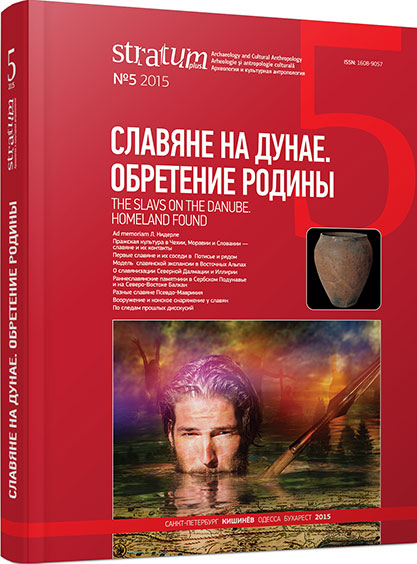К изучению культуры с керамикой пражского типа на территории Моравии: формирование и особенности
On the problem of Prague-Type Pottery Culture in Moravia: the origins and specifics
Author(s): Dagmar JelínkováSubject(s): History, Archaeology, Cultural history, Middle Ages, 6th to 12th Centuries
Published by: Издательский дом Stratum, Университет «Высшая антропологическая школа»
Keywords: Moravia; Prague-Type Pottery culture; dating; cultural relations to the east and south-east; influence of the Merovingian sphere
Summary/Abstract: The article is dealing with characteristics and dating of the earliest Slavic culture with Prague-type pottery (PTP) in the area to the north of the Middle Danube, particularly in Moravia. It also addresses the question of which traditions and influences have formed the PTP culture in Moravia. In this regard it points to its origin in the area of East Europe, but the relations to the south-eastern territory between the Carpathian arch, the Lower Danube and Dnieper are also provable. Here, north of the Byzantine empire, extended the Penkovka culture, whose influence was also reflected in some small metal objects of the PTP culture, which were found on the territory of Bohemia, Moravia and Slovakia. Direct influence of Byzantium has been identified in finds such as bronze bracelets or a bronze buckle from Mutěnice.In the area between the Lower Danube and the Carpathian arch one can probably also seek the origin of the relatively frequent finds of engraved crosses on pottery. In South Romania, this phenomenon has been considered evidence of penetration of Christianity into the sphere of the local sedentary population. Such an explanation for similar ceramic finds in the area north of the Middle Danube, however, is probably hardly to imagine in case of Moravia. Possible is the adoption of these elements from the area of South-east Europe, but without any analogous interpretation.The most frequent finds of PTP culture on the territory of Moravia, which in the previous period has been inhabited by people of the Merovingian culture with inhumation graves, can be dated according to new 14C analyses to the second half or to the end of the 6th century. This dating, however, gives rise to the question, to what extent the population of PTP culture came into contact with preceding environment of inhumation graveyards attributed to the historical Langobards, and whether at all or how its material culture was influenced by older Merovingian traditions. Some of the items from archaeological inventory, above all the long unilateral combs, as well as sporadic examples of metal artefacts, glass beads and unusual ceramic types, might indicate possible impact of Merovingian cultural traditions. An evidence of this contact can also be inhumation grave no. 114, which was found in a clear context with cremation burials with Prague-type pottery at Přítluky, Břeclav district. Its inventory and burial rite reflect tight connections to cultural displays of the Merovingian sphere. The possibility of certain, even though only temporary, contemporaneousness and coexistence of such different culturalenvironments in the Middle Danube region is also indicated by several more recent finds, which are mentioned in the end of the paper.
Journal: Stratum plus. Археология и культурная антропология
- Issue Year: 2015
- Issue No: 5
- Page Range: 117-150
- Page Count: 34
- Language: Russian
- Content File-PDF

